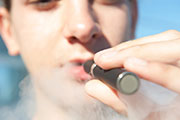- Navigating Your Midlife Crisis: Embracing New Possibilities
- City Raccoons Showing Signs of Domestication
- Mapping the Exposome: Science Broadens Focus to Environmental Disease Triggers
- One Week Less on Social Media Linked to Better Mental Health
- Your Brain Changes in Stages as You Age, Study Finds
- Some Suicide Victims Show No Typical Warning Signs, Study Finds
- ByHeart Formula Faces Lawsuits After Babies Sickened With Botulism
- Switch to Vegan Diet Could Cut Your Greenhouse Gas Emissions in Half
- Regular Bedtime Does Wonders for Blood Pressure
- Dining Alone Could Mean Worse Nutrition for Seniors
FDA to Propose E-Cigarette Regulations


The U.S. Food and Drug Administration is proposing long-awaited regulations governing the fast-growing electronic cigarette industry.
The new rules, to be made public Thursday, are expected to regulate e-cigarettes as tobacco products, placing them under the same requirements as cigarettes. That would likely include a ban on the sale to minors.
“That would be a little less stringent than if they were regulated as medicinal products used in smoking cessation,” said Dr. Hilary Tindle, assistant professor of medicine and director of the tobacco treatment service at the University of Pittsburgh Medical Center.
The FDA said the public, the electronic cigarette industry and others will have 75 days to comment on the proposed regulations. Then the agency will review those comments before issuing a final rule. There’s no timetable for the final rule, which will probably end up facing a court challenge, the Associated Press reported.
Mitch Zeller, director of the FDA’s Center for Tobacco Products, said: “When finalized [the proposal] would result in significant public health benefits, including through reducing sales to youth, helping to correct consumer misperceptions, preventing misleading health claims and preventing new products from entering the market without scientific review by FDA,” the AP reported.
E-cigarettes are battery-operated devices that turn nicotine, flavorings and other chemicals into a vapor that can be inhaled. Most are designed to look like a tobacco cigarette, but some look like pens, USB drives or other everyday objects.
The devices are advertised on TV and the Internet, and come in sweet flavors like green apple, watermelon and bubble gum.
The new proposed regulations also are expected to rein in a number of tobacco products that up to now have had no federal oversight.
“It would give FDA authority over all unregulated tobacco products,” said Erika Sward, the American Lung Association’s assistant vice president for national advocacy. “That would be e-cigarettes, but it also would be cigars, little cigars, hookah-type tobacco and any other products that aren’t currently under the FDA’s authority now.”
Such regulations would close a huge loophole that allows children to freely purchase e-cigarettes and little cigars in many parts of the country, according to proponents of stricter regulations.
E-cigarette use more than doubled among middle and high school students from 2011 to 2012, with more than 1.78 million students nationwide inhaling nicotine-laced vapor from the devices, the U.S. Centers for Disease Control and Prevention reported last year.
“What’s concerning is that high rate of rise,” Tindle said. “Who knows where it will be next year, or the year after that? Everyone agrees that’s not a good thing. The least amount of regulation has to close that hole, so children can’t get access to them as easily.”
The drive for regulation is also being fueled by a dramatic increase in the number of calls to poison centers involving nicotine poisonings from e-cigarettes, according to federal health officials.
Calls related to poisoning from the liquid nicotine in the devices rose from about one a month in 2010 to 215 in February this year, the CDC reported in April.
Electronic cigarettes may be safer than conventional tobacco cigarettes, in that people don’t have to inhale harmful smoke. But without regulation, it’s impossible to know what people are inhaling when they use an e-cigarette, Tindle said.
“There are so many manufacturers right now making e-cigarettes, and there have been multiple reports of contaminants in the vapor and in the e-liquids,” she said. “People don’t necessarily know what they are getting in their bodies, based on the label.”
The new regulations would end the “Wild West” nature of the e-cigarette market, Sward said.
“Once these companies come under FDA authority, it would require them to register with the FDA to disclose their products and ingredients. That’s really important in understanding how these new products impact public health,” she said.
Given the lack of federal action so far, some states and cities have started pursuing e-cigarette regulations of their own. New York City added e-cigarettes to the city’s overall ban on smoking in December, treating them the same as tobacco products.
Some argue that e-cigarettes can help people quit smoking, but evidence supporting that claim has been mixed. Recent studies published in The Lancet and JAMA Internal Medicine have reported that e-cigarettes either don’t help people quit or are about as effective as a nicotine patch.
If the FDA decides to regulate e-cigarettes as tobacco products, some companies may decide to proceed with clinical trials that would allow them to market the devices as safe and effective smoking-cessation devices, Tindle said.
More information
For more on e-cigarettes, visit the U.S. National Institute on Drug Abuse.
Source: HealthDay
Copyright © 2025 HealthDay. All rights reserved.










